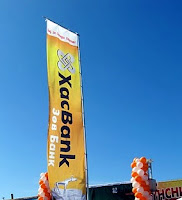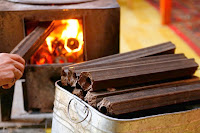By Beth Ritchey, Kiva Fellows 10th Class, Ulaanbaatar, Mongolia
Yes, it might be the dead of winter in Mongolia, with temperatures hovering around -30 degrees Fahrenheit, but the loan products here have been turning green. Thanks to the hard work of the Eco Products Team at XacBank in Mongolia, Kiva lenders saw an introduction of 3 new types of personal consumption ‘green loans’ in December 2009:- Energy Efficient Stoves
- Ger (yurt) covers
- Energy efficient fuel
Currently around 60% of the population of Ulaanbaatar (the capital of Mongolia) lives in gers (a yurt-like structure heated by a central stove). Pollution is a big problem in Ulaanbaatar, especially in the winter when pollution levels increase substantially due to the extra coal and wood burned in the gers to keep warm. The World Bank estimates that 60% of the pollution in the city during the heating season is attributed to coal burned in the Ger Districts*.
XacBank recognized this problem and its connection with poverty. Most families spend up to 40% of their incomes, roughly a $140 per month, in the winter time on heating fuel alone. This money most often comes from cuts in nutrition and health budgets*. To address this relationship between pollution and poverty, XacBank started offering new loans to make eco products financially accessible to the residents of the Ger Districts. XacBank currently offers 3 types of green loans for personal consumption: energy efficient stoves, ger covers and energy efficient fuel.
The energy efficient stoves were developed and tested by GTZ, an international enterprise for sustainable development run by the German Government. The stoves are lined with a type of brick similar to that found in a pottery kiln and are designed to circulate and retain heat for longer periods than traditional stoves. This in turn reduces fuel consumption by more than 60% each month and helps to reduce a family’s air pollution.
Ger covers are essentially large insulating blankets composed of three separate layers that wrap the entire outside of the ger. The specialized insulation helps to keep heat within the ger and results in a 50% reduction in fuel burned each month. The Ger covering was designed by the United Nations Development Program, but is produced locally in Mongolia. As an additional note, XacBank provided start-up loans to local producers to increase production of both the stove and the ger cover.
The third XacBank Eco loan is for energy efficient fuel. Borrowers can obtain a loan to buy fuel from producers who create efficient fuels from things like compacted sawdust and gasified coal. The efficient fuels are more expensive than traditional fuels but they have less of a negative impact on the environment by burning longer and producing less carbon output. Overall, the price difference between clean fuels and brown coal is made up through clients using less fuel to achieve the same heating results.
The majority of XacBank’s green loans are posted in the fall, as Mongolians prepare their gers for winter and stock up on fuel. To date, XacBank has posted 22 green loans on Kiva and plans to do more in the future, so keep an eye out for new eco-loans coming soon! In the meantime you can also check out XacBank’s carbon partnership with yurtcozy which is helping to make the program sustainable.
*Energy Efficient and Cleaner Heating in Poor, Peri-urban Areas of Ulaanbaatar, World Bank Consultant Summary Report on Activities, October 2008
This story was originally posted on "Kiva Stories from the Field" on February 23, 2010. Please click here to see the original post.
PREVIOUS ARTICLE
Kiva Quote of the Week →NEXT ARTICLE
“The Apprentice” Should Hold Auditions in the Philippines →



















